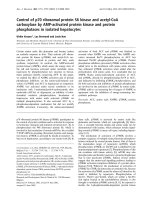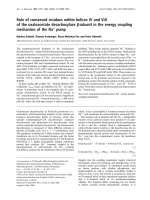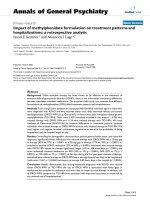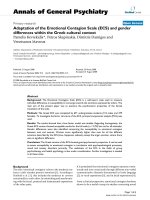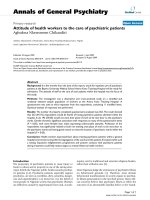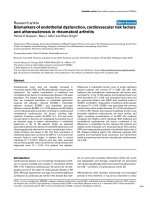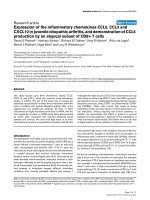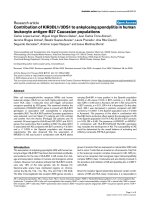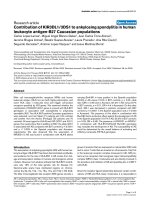Báo cáo y học: "Adaptation of Rhizobium leguminosarum to pea, alfalfa and sugar beet rhizospheres investigated by comparative transcriptomics" docx
Bạn đang xem bản rút gọn của tài liệu. Xem và tải ngay bản đầy đủ của tài liệu tại đây (410.39 KB, 44 trang )
This Provisional PDF corresponds to the article as it appeared upon acceptance. Copyedited and
fully formatted PDF and full text (HTML) versions will be made available soon.
Adaptation of Rhizobium leguminosarum to pea, alfalfa and sugar beet
rhizospheres investigated by comparative transcriptomics
Genome Biology 2011, 12:R106 doi:10.1186/gb-2011-12-10-r106
Vinoy K Ramachandran ()
Alison K East ()
Ramakrishnan Karunakaran ()
Allan Downie ()
Philip S Poole ()
ISSN 1465-6906
Article type Research
Submission date 10 August 2011
Acceptance date 21 October 2011
Publication date 21 October 2011
Article URL />This peer-reviewed article was published immediately upon acceptance. It can be downloaded,
printed and distributed freely for any purposes (see copyright notice below).
Articles in Genome Biology are listed in PubMed and archived at PubMed Central.
For information about publishing your research in Genome Biology go to
/>Genome Biology
© 2011 Ramachandran et al. ; licensee BioMed Central Ltd.
This is an open access article distributed under the terms of the Creative Commons Attribution License ( />which permits unrestricted use, distribution, and reproduction in any medium, provided the original work is properly cited.
1
Adaptation of Rhizobium leguminosarum to pea, alfalfa and sugar beet rhizospheres
investigated by comparative transcriptomics
Vinoy K Ramachandran
1
, Alison K East
2
, Ramakrishnan Karunakaran
2
, J Allan
Downie
2
and Philip S Poole
2*
1
School of Biological Sciences, University of Reading, Reading, RG6 6AJ, United
Kingdom.
2
Department of Molecular Microbiology, John Innes Centre, Norwich Research Park,
Norwich, NR4 7UH, United Kingdom.
* Correspondence:
2
Abstract
Background: The rhizosphere is the microbe-rich zone around plant roots and is a key
determinant of the biosphere’s productivity. Comparative transcriptomics was used to
investigate general and plant-specific adaptations during rhizosphere colonization.
Rhizobium leguminosarum biovar viciae was grown in the rhizospheres of pea (its
legume nodulation host), alfalfa (a non-host legume) and sugar beet (non-legume). Gene
expression data was compared to metabolic and transportome maps to understand
adaptation to the rhizosphere.
Results: Carbon metabolism was dominated by organic acids, with a strong bias towards
aromatic amino acids, C1 and C2 compounds. This was confirmed by induction of the
glyoxylate cycle required for C2 metabolism and gluconeogenesis in all rhizospheres.
Gluconeogenesis is repressed in R. leguminosarum by sugars, suggesting that although
numerous sugar and putative complex carbohydrate transport systems are induced in the
rhizosphere, they are less important carbon sources than organic acids. A common core of
rhizosphere-induced genes was identified of which 66% are of unknown function. Many
genes were induced in the rhizosphere of the legumes, but not sugar beet and several
were plant specific. The plasmid pRL8 can be considered pea rhizosphere specific,
enabling adaptation of R. leguminosarum to its host. Mutation of many of the up-
regulated genes reduced competitiveness for pea rhizosphere colonisation, while two
genes specifically up-regulated in the pea rhizosphere reduced colonization of the pea but
not alfalfa rhizosphere.
3
Conclusions: Comparative transcriptome analysis has enabled differentiation between
factors conserved across plants for rhizosphere colonisation as well as identification of
exquisite specific adaptation to host plants.
Background
Interactions between micro-organisms and plant roots in the rhizosphere are a key
determinant of plant productivity. There is a two-way dialogue in which plants
manipulate the rhizosphere’s microbial community which, in turn, profoundly alters plant
growth [1]. Plants exude up to 11% of fixed carbon via their roots, including both small
organic compounds and those that act as signalling molecules [2]. Carbon export on this
scale must have a significant impact on rhizosphere micro-organisms leading to
alterations in community structure and function. The rhizosphere is an environment in
which there are co-evolved mutualistic relationships between plants and microbes [1].
The best characterized beneficial associations are mutualisms with Rhizobium and
mycorrhizae, but many other bacteria promote plant growth [1].
The symbiosis between rhizobia and legume hosts has been studied in great detail,
because their reduction of atmospheric N
2
to ammonium is one of the largest inputs of
available nitrogen into the biosphere [3]. Colonization of legume roots by rhizobia
induces development of root nodules; in most studied systems, plant-released flavonoids
induce rhizobia to synthesize lipochitooligosaccharide Nod factors, which induce root
hair deformation and nodule morphogenesis [3]. Rhizobia are entrapped by curling root
hairs and induce the plant to form infection threads which grow through the root hair and
root cortical cells, leading to nodule formation. Bacteria are released from infection
threads by endocytosis and surrounded by a plant membrane which controls exchange of
4
carbon and nitrogen between the plant cytosol and rhizobia [4]. Despite detailed
knowledge of root hair infection and nodule formation in legumes, little is known about
the critical steps of rhizosphere colonization. By comparing R. leguminosarum
colonization of the rhizosphere of its host legume with that of a non-host legume and a
non-legume we have been able, for the first time, to draw general conclusions about life
in the plant rhizosphere as well as examine specific adaptation to a legume host.
Results and discussion
Rhizobia have a special advantage for a study of the plant rhizosphere as bacterial
responses can be investigated during colonisation of the rhizosphere of a specific host
legume (e.g. pea), a non-host legume (alfalfa) and a non-legume (sugar beet). In addition,
we are able to chart metabolic activity in the rhizosphere by comparison to the
Sinorhizobium meliloti transportome, which comprises a large induction map for 76
identified ABC and TRAP transport systems in rhizobia [5]. This induction map was
extended in this study with a series of microarrays of free-living cultures grown on a
variety of metabolites (Table 1).
At the start of this study three variables were compared: (i) length of incubation of
bacteria in the rhizosphere (bacteria harvested at 1, 3 and 7 days post inoculation (dpi) of
7d-old pea plants (Table 1, Figure S2 in additional file 1)); (ii) age of the plant ( bacteria
harvested at 1 dpi of 7, 14 and 21 d-old pea plants (Table 1, Figure S3 in additional file
2)), (iii) level of bacterial inoculum (10
3
or 10
8
CFU (7dpi of 7d-old peas) (Table 1,
Figure S4 in additional file 3)).
Incubating bacteria in the pea rhizosphere for 7dpi was chosen as the standard
incubation because it gave the highest number of ≥ 3-fold differentially regulated genes
5
(7 dpi (764) > 3dpi (682) > 1dpi (638)) (Figure S2 in additional file 1). Seven day-old
plants were chosen because this gave the largest number of ≥3-fold differentially
regulated genes (7 d-old plants (635) > 21d (441) >14d (171 )) (Figure S3 in additional
file 2). In addition 138 genes were specifically up-regulated in 7d-old pea plants (Figure
S3 in additional file 2) including many genes of interest (e.g. rhi genes pRL10169-171,
cinI (RL3378) and nod genes pRL100180, pRL100183, pRL100186-188), which we
assume are induced by young, fast growing roots but not by those of older plants. An
inoculum of 10
8
CFU rhizobia was chosen because it resulted in more differentially
expressed genes (Figure S4 in additional file 3) and RNA recovery was more reliable.
With the standard conditions established R. leguminosarum bv. viciae Rlv3841
was inoculated at 10
8
CFU into the rhizosphere of 7 day-old pea, alfalfa or sugar beet
plants and bacteria harvested 7 dpi. The gene induction pattern was compared against
glucose-grown laboratory cultures, leading to an indirect comparison of rhizospheres
(Table 1, Figure S1 in additional file 4). By contrast, relative levels of gene induction
were also directly compared from bacteria isolated from the rhizospheres of two different
plants (i.e. pea: alfalfa, pea:sugar beet and alfalfa:sugar beet) (Table 1, Figure S1 in
additional file 4, Figure S5 in additional file 5). Thus the results of two independent
methods could be compared.
Increased gene expression was classified as general (i.e. elevated in all plant
rhizospheres) or specific, either for the rhizospheres of legumes or individual plant
species (Figure S1 in additional file 4, Table S1 in additional file 6). Seventy of the 106
genes up-regulated in all rhizospheres tested compared to glucose-grown bacteria (Figure
S1 in additional file 4, Table S2 in additional file 7) are annotated as hypothetical
6
(compared to 27% of the genome), even permitting for a degree of mis-annotation, this
suggests synthesis of proteins of novel function. A similar observation has been made for
Pseudomonas [6]. As our purpose was to integrate information about metabolism and
cellular function in the rhizosphere, we have avoided a tedious list of genes and instead
distilled key features of bacterial life in the rhizosphere into diagrams for membrane
transport (Fig. 1), metabolism (Fig. 2) and cellular activities (Fig. 3) (data in Table S4 in
additional file 8).
In order to determine the importance of bacterial genes up-regulated in the
rhizosphere, competition assays were performed in the pea rhizosphere between wild-
type Rlv3841 and 46 strains, each mutated in one of these up-regulated genes (Table S4
in additional file 8). These genes were chosen after the initial screen of genes up-
regulated in the pea rhizosphere versus glucose grown laboratory cultures. Pea was used
because it is the host plant for R. leguminosarum. However, two mutants were also tested
in both pea and alfalfa rhizospheres because subsequent gene expression analysis showed
they are specifically up-regulated in the pea rhizosphere. In these mutants it would be
expected that any impairment in competition would be restricted to the pea rhizosphere.
Mutants were scored with a rhizosphere colonisation index (RCI); as described in
methods, a RCI of 1 indicates equal competitiveness with Rlv3841, and the lower the
RCI (down to 0.35), the less able the strain is to compete with Rlv3841 (Table S4 in
additional file 8). Thus a low RCI indicates that the mutation is in a gene which is
important for the strain to colonise the rhizosphere.
General adaptation to the rhizosphere: Cellular factors
7
Genes induced in all three plant rhizospheres reflect general life in the rhizosphere and
we consider these before examining responses specific to one plant (Table S2 in
additional file 7). They include elevated expression of rhiABC (pRL100169-171) and rhiI
(pRL100164), previously described as rhizosphere-induced genes [7] and the gene for
autoinducer synthesis protein CinI (RL3378) involved in coordinating quorum-sensing
regulation and biofilm formation (Fig. 3). Quorum sensing is likely to be important in
rhizosphere biology, where bacterial attachment is a key step in root colonisation [7].
Expression of genes encoding an alternative aa
3
-type cytochrome c oxidase complex
(RL3041-45) and a possibly associated cytochrome c (RL3046) were induced in the
rhizosphere (Fig. 3). This rhizosphere-induced cytochrome pathway, which is distinct
from both the normal cytochrome aa
3
complex found in laboratory cultured bacteria and
the high affinity cytochrome cbb
3
complex found in the N
2
-fixing nodule form of rhizobia
[8], suggests a distinct redox environment in the rhizosphere. It may be that in the
rhizosphere the level of available oxygen is lower than in shaken laboratory culture but
higher than in the microaerophilic conditions found inside legume nodules.
General adaptation to the rhizosphere: Metabolism and transport
Up-regulation of genes encoding C4-dicarboxylate transport protein, DctA (RL3424)
(Fig. 1) and PEP carboxykinase, PckA (RL0037) (Fig. 2) reveals increased organic acid
metabolism in the rhizosphere. Induction of pckA is required for gluconeogenesis and
indicates sugar synthesis. R. leguminosarum represses pckA when grown on organic acids
with added sugar [9] so while sugars are present in the rhizosphere (i.e. based on
induction of sugar transporters), central metabolism is almost certainly dominated by
8
catabolism of organic acids. Soils are rich in organic acids and they are the main carbon
sources in the tomato rhizosphere [10]. Mutations in both dctA (RL3424) and pckA
(RL0037) decreased the ability of R. leguminosarum to compete in the pea rhizosphere as
shown by RCIs of 0.65 and 0.57 respectively (Table S4 in additional file 8).
The glyoxylate cycle was induced showing that short chain (C2) organic acids are
catabolized (Fig. 2). C1 metabolism is important based on the induction of NAD
+
-
dependent formate dehydrogenase (RL4391-3) in all rhizospheres (Fig. 2). Formate
induced this operon in a laboratory culture of Rlv3841 (Table S3 in additional file 9) and
is a carbon source for autotrophic growth of S. meliloti [11]. Formate dehydrogenase
(RL4391-3) requires a Mo cofactor and the gene encoding MoaA2 (RL2711), involved in
molybdenum cofactor biosynthesis, showed elevated expression (Fig. 2). Mutation of
moaA2 (RL2711) resulted in a RCI of 0.73 in the pea rhizosphere (Table S4 in additional
file 8). In addition, in all the rhizospheres tested there was induction of an ABC
transporter solute binding protein (SBP) (RL3040) from the MolT family (ABC families
are according to Saier [12]), which is likely to be part of an uptake system for molybdate
(Fig. 1 and Table S5 in additional file 10).
Aromatic compounds are important precursors or breakdown products of many
plant compounds and can be used as a source of carbon by rhizosphere bacteria. Their
presence in the rhizosphere is illustrated by induction of genes encoding transport
systems for uptake of shikimate and protocatechuate. Shikimate is taken up by a multi-
facilitator super-family (MFS) transporter (RL4709). Protocatechuate is imported by a
tripartite ATP-independent periplasmic (TRAP) transporter (pRL120499-pRL120500)
(Fig. 1), which was identified by high level induction of pRL120498-500 in microarrays
9
of cells grown in the presence of protocatechuate (Table S3 in additional file 2 and Table
S5 in additional file 5). In the pea rhizosphere, mutation of pRL120500 led to a RCI of
0.72 (Table S4 in additional file 8). Catabolism of aromatic compounds has also been
shown to be important for Pseudomonas putida in the rhizosphere of Zea mays [13].
One of the strongest general metabolic responses in the rhizosphere was induction
of genes encoding proteins involved in catabolism of phenylalanine and tyrosine
(RL1860-6) (Fig. 2). These genes were also induced in free-living cells grown on
phenylalanine (Table S3 in additional file 9). The presence of phenylalanine in the
rhizosphere probably results from its important role as a precursor for lignin synthesis by
roots. Mutation of two genes encoding enzymes on this phenylalanine breakdown
pathway (RL1860 and RL1863, Fig. 2) led to two of the largest reductions in pea
rhizosphere competitiveness (RCIs of 0.42 and 0.45 respectively, Table S4 in additional
file 8).
Common to all rhizospheres was induction of genes for uptake systems for
inositol (IntA, RL4655) [8, 14] and sorbitol/mannitol/dulcitol (MtlE, RL4218). Also
elevated were genes encoding components of two previously uncharacterised systems.
The first, RL3840, encodes a CUT1 family SBP likely to transport raffinose, melibiose
and lactose based on 91% identity to SMb20931 from S. meliloti, whose expression was
induced by these sugars [5]. The second, pRL110281, which encodes a PepT family SBP,
is clearly important in the pea rhizosphere since mutation of the gene led to a RCI of 0.44
(Table S4 in additional file 8). The contiguous gene, pRL110282, encodes a product with
putative α-N-arabinofuranosidase activity that could be responsible for removing
arabinose subunits from arabinan. Based on this proximity, pRL110281 may import the
10
arabinose polymer arabinan, or an oligosaccharide derived from it. Indeed, pRL110281 is
unlikely to transport arabinose as its gene was not induced in laboratory cultures grown
on arabinose (Table S3 in additional file 9). Growth on arabinose did cause induction of
genes encoding components of CUT2-family transporters, RL3615-6 and RL2377-8
(Table S3 in additional file 9 and Table S5 in additional file 10), neither of which was
elevated in the rhizospheres tested.
Co-induction of transport systems and metabolic pathways provides additional
evidence of the presence of a compound in the rhizosphere. The gene encoding mannitol
dehydrogenase (MalK, RL4214), which converts mannitol to fructose was elevated (Fig.
2) along with those of a mannitol uptake system (MtlE (RL4218), Fig. 1). Although intA
(RL4655) encoding the myo-inositol transporter was induced, genes for inositol
catabolism were not. Induction of uptake genes may occur at lower substrate
concentrations than for catabolic genes, and there are many examples in our data where
catabolic genes were less induced than corresponding transport genes.
The genes encoding a CUT1 family ABC system (RL3860-2) were induced in all
rhizospheres and although the solute specificity of this system is unknown, it clearly has a
role in the pea rhizosphere as a mutation in RL3860 led to a RCI of 0.58 (Table S4 in
additional file 8). The transporter genes are surrounded by genes encoding predicted
mandelate racemase/muconate lactonising proteins (RL3858, RL3864-66), a family of
enzymes involved in breakdown of lignin-derived aromatic compounds, protocatechuate
and catechol to intermediates of citric acid cycle via the β-ketoadipate pathway. Although
the transport genes were induced in all rhizospheres, of the genes encoding lignin
11
breakdown enzymes only RL3864 was slightly elevated in the alfalfa rhizosphere (1.5-
fold, p ≤0 .05) and RL3866 in the pea rhizosphere (1.4-fold, p ≤ 0.05).
Examination of ABC transporters with unknown solute-specificity shows that
11genes encoding CUT1 transporters were induced in plant rhizospheres (Fig. 1). An
increase of expression of CUT1 systems, which usually import oligosaccharides and their
derivatives, is consistent with the presence in the rhizosphere of many different poly- and
oligosaccharides. In addition, some members of the PepT class also transport
oligosaccharides e.g. α-galactoside (Agp) transporter (pRL110243, Fig. 1) [15]. Genes
for five PepT transporters were induced in these rhizospheres, with three of unknown
solute-specificity induced only in the alfalfa rhizosphere (pRL90101, pRL120243 and
pRL120609-10, Fig. 1). This work supports the hypothesis that the large increase in
number of high-affinity ABC systems in rhizobia (and other α-proteobacteria) results
from selective adaptation to the oligotrophic nature of soil and rhizosphere.
General adaptation to the rhizosphere: Dealing with adversity
Plants produce antimicrobial agents (e.g. phytoalexins) which bacteria must degrade or
export. Plant-made antimicrobials such as halogenated hydrocarbons (e.g.
dichloroethane) could be dealt with by induction of RL4047 and RL4267 whose products
may catalyse conversion of dichloroethane via chloroacetic acid to glycolate, with further
degradation by the glyoxylate cycle (Fig. 2). RL4267 shows 84% identity to a
Xanthobacter autotropicus enzyme involved in 1,2-dichloroethane degradation [16].
Mutation of RL4267 resulted in a strain with reduced competiveness in the pea
rhizosphere (RCI = 0.47, Table S4 in additional file 8). There have been descriptions of
12
other haloalkanoate dehalogenases in Rhizobium sp. [17] suggesting halogenated
hydrocarbons may act as antimicrobials around roots.
In addition to metabolic detoxification, expression of the Multi-Drug Resistance
(MDR) family efflux pump encoded by rmrA (pRL90059) was elevated (Fig. 1). RmrA is
a MFP (Membrane Fusion Protein) whose role is typically to dock an inner membrane
exporter to a TolC like protein that spans the periplasm and outer membrane. An R. etli
rmrA mutant produced 40% less nodules on bean roots and had increased sensitivity to
phytoalexins, flavonoids and salicylic acid [18]. Another MFP elevated in all
rhizospheres is encoded by RL4274, a RND (Resistance-Nodulation-cell Division) multi-
drug exporter (Fig. 1). The importance of this system in the pea rhizosphere is
demonstrated by a mutant of RL4274 having a RCI of 0.57 (Table S4 in additional file 8).
Maintaining the correct osmotic environment is important for bacteria in any
situation. In all rhizospheres there was elevated expression of ndvA (RL4640). NdvA is
responsible for export of cyclic β -1-2-glucan to the bacterial periplasm and important in
rhizobia for hypoosmotic regulation [19] (Fig. 1). Expression of RL1908, encoding a
small-conductance mechanosensitive ion channel MscS, was also elevated in the
rhizospheres examined (Fig. 1) and is important in osmotic homeostasis. This suggests
that the test microcosm was mildly hypoosmotic.
Elevation of expression of genes involved in response to stress occurred in all
rhizospheres (Fig. 3). Mutation of RL3982 and RL4265 (msrB) encoding general- and
oxidative-stress proteins reduced pea rhizosphere competitiveness (RCIs of 0.52 and 0.55
respectively, Table S4 in additional file 8). Some of the largest effects on ability to
compete in rhizospheres were shown by mutation of genes encoding proteins of unknown
13
function; photo reaction centre (PRC) family protein RL0913 and flavoprotein RL3366
had RCIs of 0.42 and 0.43 respectively in the pea rhizosphere (Table S4 in additional file
8). Mutation of RL2946, encoding part of a two-component sensor regulator (Fig. 3), led
to a RCI of 0.59 in the pea rhizosphere (Table S4 in additional file 8).
Specific adaptation to legume rhizospheres
The largest class of genes induced only in legume rhizospheres were the nod genes
(nodABCEFIJLMNO), required for synthesis and export of nodulation factors (Fig. 3).
This acts as an exquisite internal control since nodulation factors are specifically induced
in response to secretion of flavonoids by legumes [3]. There is also a legume rhizosphere-
specific transporter encoded by pRL90085 (Fig. 1) shown to be important in the pea
rhizosphere as mutation led to a RCI of 0.52 (Table S4 in additional file 8). Although the
solute is unknown it is probably a monosaccharide, as pRL90085 is in the CUT2 family.
Specific adaptation to the pea rhizosphere
Increased expression of genes encoding enzymes of the glyoxylate cycle (RL0054,
RL0866) only occurred in the pea rhizosphere. RL0054 (malate synthase) forms malate
from glyoxylate and acetyl CoA while GlcF (RL0866) probably converts glycolate to
glyoxylate (Fig. 2). Thus while C2 metabolism is elevated in all rhizospheres, it is
particularly important in that of pea. Curiously, although the gene for isocitrate lyase
(RL0761 (aceA)) was up-regulated in both alfalfa and sugar beet rhizospheres indicating
elevated C2 metabolism, expression of RL0054, encoding malate synthase, was only
elevated in that of pea (Fig. 2).
14
The gene for MFS transporter of tartrate (RL0996) was induced ≥3-fold in the pea
rhizosphere (Fig. 1, Table S2 in additional file 7) while that for tartrate dehydrogenase
(RL0995), which converts tartrate to oxaloglycolate for metabolism by the glyoxylate
cycle, was only induced by legumes [20] (Fig. 2). Mutation of RL0996, encoding the
tartrate transporter, led to the largest effect on ability to compete in the pea rhizosphere
(RCI = 0.35, Table S4 in additional file 8). RL0996 was also induced 1.5- fold in the
alfalfa rhizosphere so although this falls below our 2-fold cut off it suggests tartrate
utilisation may be important in legume rhizospheres (Table S4 in additional file 8).
However, tartrate may be more generally important as in Agrobacterium vitis the ability
to utilize tartrate offered a selective advantage for growth on grapevine [21].
The importance of pRL8 in the pea rhizosphere
R. leguminosarum Rlv3841 has a chromosome and six plasmids designated pRL7-
pRL12, with pRL10 containing most nodulation and nitrogen fixation genes [22].
Although pea rhizosphere-induced genes from different parts of the genome have been
discussed above, many genes on pRL8 are specifically up-regulated in the pea
rhizosphere (Fig. 4 and Table S1 in additional file 6). Indeed, 37% (11 genes) of the 30
genes ≥ 3-fold elevated specifically in the pea rhizosphere (using both direct and indirect
comparisons (Table S2 in additional file 7)) are encoded on pRL8. With a threshold of
up-regulated at ≥2-fold, p ≤0 .05 then 21 genes on pRL8 are pea rhizosphere-specific
(15% of all genes on pRL8). By comparison only 3 and 2 genes on pRL8 were up-
regulated in alfalfa and sugar beet rhizospheres respectively and 2 genes were up-
regulated in the legume rhizosphere. Since plasmid pRL8 is conjugative [22], it can
15
easily transfer between rhizobia. Consistent with its heavy bias to genes important in the
pea rhizosphere, pRL8 shows little colinearity (< 5%) with other sequenced rhizobial
genomes [23]. BLAST analysis shows that of its 142 genes, 25% are only found in R.
leguminosarum bv viciae and a further 42% are specific to rhizobia or related α-
proteobacteria.
Genes on pRL8 that are pea rhizosphere-specific include a molybdenum-
containing xanthine dehydrogenase-like carbon monoxide dehydrogenase CoxMSL
(pRL80023-25) together with accessory protein CoxG (pRL80021). Nearby are genes for
proteins which may be involved in maturation of this complex: proteins involved in
molybdopterin biosynthesis (pRL80034 and pRL80033 MoaA and MoeA-like proteins
respectively) and CoxI (pRL80038) which is needed for insertion of molydopterin
cofactor into a xanthine dehydrogenase. However, while CoxMSL (pRL80023-25) may
be able to catalyse CO conversion to CO
2
(Fig. 2), in phylogenetic clustering these
proteins form a separate clade from the biochemically characterised CO dehydrogenases,
including one from Bradyrhizobium japonicum [24]. Mutation of pRL80021 (coxG) and
pRL80023 (coxM) resulted in reduced competitiveness in the pea rhizosphere (RCIs of
0.44 and 0.73 respectively, Table S4 in additional file 8). Since pRL80021 is only up-
regulated in the pea rhizosphere, its mutation did not result in reduced competitiveness in
the alfalfa rhizosphere (RCI 0.97, Table S4 in additional file 8).
Homoserine is abundant in pea root mucilage and can be utilized as a carbon
source by R. leguminosarum [25]. Although the genes involved in catabolism of
homoserine are uncharacterized in Rlv3841, pRL80071, encoding a putative homoserine
16
dehydrogenase (which catalyses conversion of homoserine to L-aspartate-semialdehyde),
was specifically up-regulated in the pea rhizosphere (Fig. 2).
Tryptophan is probably available in the rhizosphere [26]. The gene encoding N-
formylkynurenine formidase (pRL80036) was 6-10-fold elevated in the pea rhizosphere
(Fig. 4). It catalyses release of formate and kynurenine from N-formylkynurenine, formed
after the first step in tryptophan catabolism. The formate produced might be further
metabolised to CO
2
by NAD
+
-containing short-chain dehydrogenase encoded by
pRL80037, whose expression is 2.5-3.5-fold elevated (Fig. 4).
Mimosine (β-3-hydroxy-4 pyridone amino acid), a toxic amino acid related to
tyrosine, is produced by the tree-legume leucaena which is nodulated by Rhizobium sp.
TAL1145. Rhizobium sp. TAL1145 has a specific ABC importer for mimosine
(MidABC) and an aminotransferase responsible for its degradation (MidD) [27]. An ABC
importer (encoded by pRL80060, pRL80063-4) (Fig. 1), which shows 44-79% identity to
MidABC [27], was induced in the pea rhizosphere. However, there is no protein in
Rlv3841 with > 27% identity to the aminotransferase required for mimosine degradation.
While the transporter encoded by pRL80060/pRL80063-4 is unlikely to transport
mimosine, it may transport a similar amino acid. Expression of this system was also
elevated in 7d-old pea bacteroids [8], thus it may have a role in the symbiotic interaction
between Rlv3841 and pea.
Also elevated specifically in pea rhizospheres were pRL80026-30 encoding
proteins belonging to the HAAT ABC family (Fig. 1). Despite the fact that this
transporter has been annotated as a LIV (Leucine, Isoleucine, Valine) system, it could
17
transport one or more aromatic amino acid(s) or homoserine. Mutation of pRL80026
resulted in a RCI of 0.69 in the pea rhizosphere (Table S4 in additional file 8).
Dealing with adversity in the pea rhizosphere
Export of plant toxins is likely to be important for successful growth in the rhizosphere.
The gene encoding RND family exporter RL4274 was induced 3.5-2.8-fold in the
rhizospheres of alfalfa and sugar beet and 135-fold (p ≤ 0.05) in pea (Fig. 1). In addition,
secDF2 (RL0680) encodes a membrane protein specifically induced to a very high level
only in the pea rhizosphere (>100-fold, p ≤ 0.05) (Fig.1). SecDF homologues belong to
the RND exporter super-family and RL0680 may participate in metabolite- rather than
protein-export. It is clear is that SecDF2 has a key role affecting competitiveness in the
pea rhizosphere since a mutant in this gene showed a RCI of 0.45 (Table S4 in additional
file 8). In contrast, in the alfalfa rhizosphere the same mutant had a RCI of 0.97 (Table
S4 in additional file 8), showing that mutation of secDF2 has no significant effect on its
ability to compete with Rlv3841in the alfalfa rhizosphere.
The mildly hypoosmotic nature of the general rhizosphere microcosm was
revealed by the induction of genes encoding cyclic β -1-2-glucan exporter (NdvA
(RL4640)) and a mechanosensitive ion channel (MscS (RL1908)) (Fig. 1). In addition,
the gene for a second MscS (RL1522) was specifically induced in the pea rhizosphere
(Fig. 1), presumably fine-tuning the osmotic response.
Specific adaptation to the alfalfa rhizosphere
18
A dicarboxylate may be a key carbon source in the alfalfa rhizosphere since genes for the
malonate transporter (MatC, RL0992) (Fig. 1) and enzymes for malonate metabolism to
acetyl CoA (MatA, RL0990 and MatB RL0991) (Fig. 2) were induced. Alternatively, the
malonate present in the alfalfa rhizosphere may need to be detoxified as it can act as an
inhibitor of succinate dehydrogenase.
Canavanine is a toxic amino acid analogue of arginine found in seeds and
exudates of leguminous plants [28]. The canavanine exporter MsiA from Mesorhizobium
tianshanense shows 97% identity with RL2856. In Rlv3841, expression of RL2856 was
specifically elevated in the alfalfa rhizosphere (Fig. 1). Canavanine comprises 0.6-1.6%
of the dry weight of alfalfa seeds and restricts growth of bacteria [28]. MsiA (RL2856)
was slightly induced in vetch bacteroids (3.2-fold, p=0.07) [8], suggesting that vetch
releases some canavanine. MsiA is important for attachment to root hairs and survival in
rhizospheres of canavanine-producing legumes [29]. The ability to deal with toxic
canavanine may enable selection of MsiA-producing bacteria by these leguminous plants.
RL2720 encodes a CUT2 family SBP specifically induced in the alfalfa
rhizosphere (Fig. 1). From the up-regulation of expression of RL2720-2 (4-25-fold) in
microarrays of cells grown in the presence of arabinogalactan (Table S3 in additional file
9), this cluster of genes may encode an arabinogalactan transporter (Table S5 in
additional file 10). In addition, this gene cluster encodes two transketolases (RL2718-19).
Expression of RL2719 was elevated (12-fold) in the alfalfa rhizosphere (Table S2 in
additional file 7), as was that of a short chain dehydrogenase (RL2725). The proteins
encoded by these genes may have a role in arabinogalactan metabolism. These genes
were not elevated in microarrays of cells grown on galactose or arabinose (Table S3 in
19
additional file 9), indicating a response only to the polysaccharide or to oligosaccharide
break-down products (and not the monosaccharide constituents) of arabinogalactan.
Specific adaptation to the sugar beet rhizosphere
Comparative analysis reveals that the sugar beet rhizosphere is N-limited. Expression of
genes encoding glutamine synthetase II (GlnII, RL3549), the NH
4
+
transporter AmtB
(RL4564) (Fig. 1) and PAAT family importer pRL120079 (Fig. 1) was elevated, as they
were in all N-limited microarrays (Table S2 in additional file 7 and Table S3 in additional
file 9). As these experiments were deliberately conducted in N-free plant growth medium,
it is not surprising that the sugar beet rhizosphere was N-limited. However, legume
rhizospheres were not N-limited, indicating release of nitrogen into the rhizosphere,
possibly specifically because rhizobia were present.
Response to root secretions compared with growth in the rhizosphere
As useful information about how micro-organisms respond to the rhizosphere can be
obtained by incubating bacteria in root secretions [6], bacterial responses to constituent
components were measured (Table 1). Pea root exudate was added to liquid-grown cells
and microarray analysis showed 21 genes elevated ≥3-fold (p ≤ 0.05), 18 of which were
also elevated by growth in medium containing the flavonoid hesperetin (27 genes
elevated ≥3 –fold, p ≤0.05) (Table S1 in additional file 6). Common induced genes, in
addition to the nod and rhi gene clusters on pRL10 (nodABCEFIJLMNO and rhiIABC),
include RL2418, encoding a CUT1 ABC transporter (and also induced ≥3–fold in all
rhizospheres and in the presence of acetoacetate, hydroxybenzoate and protocatechuate)
20
(Table S1 in additional file 6 and Table S3 in additional file 9). Expression of RL2418 is
clearly important for pea rhizosphere growth as a mutant showed much reduced
competitiveness with Rlv3841 in the pea rhizosphere (RCI 0.43, Table S4 in additional
file 8).
Genes elevated under these two conditions (root exudate and hesperetin) form
only a small proportion of those elevated in plant rhizospheres. One reason is that root
secretions are very dilute and only induce genes responsive to low concentrations of
bioactive compounds (e.g. nod genes). Furthermore, growth in the rhizosphere involves a
far more complex series of interactions including attachment to roots, biofilm formation,
contact with a complex array of plant macromolecules and cell-cell competition.
Conclusions
Overall the comparative transcriptome approach used here has revealed bacterial
responses common to different plant rhizospheres, as well as mapping key general
responses such as organic acid, C1-C2 and aromatic amino acid metabolism. In addition,
it has highlighted specific bacterial adaptations to individual plants species and enabled
identification of specific detoxification systems, such as that for canavanine in the alfalfa
rhizosphere. Mutation of two genes (RL0680 and pRL80021) specifically induced in the
pea rhizosphere only reduced competitiveness in the pea and not the alfalfa rhizosphere.
A dramatic observation is the large number of genes located on plasmid pRL8 which are
specifically induced in the pea rhizosphere. This is particularly exciting and suggests
there may be a wealth of plant rhizosphere-specific plasmids or chromosomal islands to
be revealed by emerging high-throughput sequencing projects.
Material and methods
21
Bacterial and plant growth
R. leguminosarum strains were grown either in Tryptone Yeast (TY) [30] or Acid
Minimal Salts (AMS) as described [31]. Strains, plasmids and oligonucleotide primers
are described in Table S6 in additional file 11. Seeds of pea (Pisum sativa cv Avola),
alfalfa (Medicago sativa) or sugar beet (Beta vulgaris) were surface sterilized and grown
in 50 mL Falcon tubes containing autoclaved washed vermiculite and N-free rooting
solution [32]. Growth was at 23 ºC with a 16-h/8-h light/dark cycle for 7, 14 or 21 d
before inoculation with Rlv3841 (10
3
or 10
8
CFU). After 1, 3 and 7 d shoots were
removed and roots vortexed (5 min) in 6 mL sterile water and 12 mL RNA Protect
(Qiagen). Insoluble material was removed by filtration through four layers of sterile
muslin and centrifugation (160 x g, 1 min, 4 ºC). Bacteria were recovered by
centrifugation (12,000 x g, 10 min, 4 º C) and re-suspended (200 µL 10 mM Tris-HCl,
pH 8).
RNA isolation and microarray analysis
Total RNA was extracted, quantified, amplified and hybridized to microarrays as
described previously [8]. Results were analyzed using GeneSpring 7.2. (Agilent
Technologies, Santa Clara, CA) as described previously [8]. In brief, labeling,
hybridization and scanning were as previously described, spot recognition was performed
with Bluefuse (BlueGnome Limited, Cambridge, UK) and data was imported into
GeneSpring 7.2 (Silicon Genetics,
Redwood, Calif.). The local background value was
subtracted
from the intensity of each spot and a Lowess normalisation applied to the slide.
Log ratios of expression and p values were determined in GeneSpring 7.2. To establish a
standard technique for sampling (i.e. pea plant age on inoculation, harvest time dpi,
22
inoculum size) preliminary experiments were performed (Table 1). Pea plant age was
varied over 7, 14 and 21 days with bacterial harvest at 1dpi (Figure S2 in additional file
1). Following inoculation of 7d-old peas, the bacterial harvest was assessed at 1, 3 and 7
dpi (Figure S3 in additional file 2). The effect of Rlv3841 inoculum size (10
3
v10
8
CFU)
was analysed at7 dpi of 7 d-old peas (E-MEXP-2854, Table 1) (Figure S4 in additional
file 3). Standard conditions established were inoculation of 7d-old plants with 10
8
CFU
followed by bacterial harvest at 7dpi.
Using the standard assay conditions the first method used to compare rhizospheres
was microarray analysis of bacteria grown in a rhizosphere (that of pea, alfalfa or sugar
beet) against glucose-grown laboratory cultures (leading to an indirect comparison
between rhizospheres). Five independent biological replicates were used for pea and three
for alfalfa and sugar beet (Table 1). A second method of analysis was comparison of
samples isolated from two different rhizospheres (direct comparison) each with four
independent biological replicates taken at 7dpi of 7d-old plants (Table 1, Figure S1 in
additional file 4 and Figure S5 in additional file 5).
Gene expression for selected genes was confirmed by qRT–PCR performed in
triplicate using the QuantiTect SYBR Green PCR Kit (QIAGEN) on an MJ Mini cycler
MiniOpticon Real-Time
PCR Detection System (Bio-Rad) as previously described [33].
Primers are given in Table S6 in additional file 11. The data were analyzed by the
relative quantification method [Comparative C
T
Method (∆∆C
T
)] to calculate the fold
expression [34-35]. Expression levels
were normalized against mdh and analyzed with
REST [34]. The results from the two normalization procedures were not significantly
different (Table S7 in additional file 12).
23
Isolation of integration mutants and competition studies
R. leguminosarum bv viciae 300 (Rlv300, Str
s
) is the parent of streptomycin-resistant
(Str
r
) derivative Rlv3841. Mutations were made in 46 up-regulated genes in Rlv300 using
plasmid integration (leading to neomycin-resistant (Neo
r
) mutant colonies) as described
[8] (Table S4 in additional file 8). To assess bacterial competiveness, 7 d-old pea or
alfalfa seedlings (n = 8) were inoculated with a Neo
r
mutant (10
4
CFU) and wild-type Str
r
Rlv3841 (10
3
CFU). The 10:1 ratio of mutant to wild-type was used as the wild-type
increases its frequency very effectively against strains with attenuated competitiveness
[33], enabling detection of subtle decreases in competitiveness. After 7 d growth,
recovered bacteria were serially diluted and CFU scored on TY agar with trimethoprim
(10 µg mL
-1
) and nystatin (50 µg mL
-1
) with either Str (500 µg mL
-1
) (selects Rlv3841) or
Neo (80 µg mL
-1
) (selects mutant in Rlv300 background) as described [33]. A nifH
mutant was used as a negative control as it is only expressed in nodules and is unaffected
in ability to compete in the rhizosphere, while a thiM mutant (thiamine auxotroph) was
used as a positive control because it is severely attenuated for competitiveness in the pea
rhizosphere [33]. To establish a baseline competition between wild-type strains, where no
selective advantage is expected, Rlv300 was inoculated at 10-fold excess over Rlv3841.
Rlv3841 was recovered at 9.7% ± 0.28% (mean ± SEM, n=51) (Table S4 in additional
file 8), close to the theoretical 9.1%. Similarly, for the positive (thiM) and negative
(nifH) controls, Rlv3841 was recovered from the rhizosphere at 71.6% ± 1.6 % and
10.0% ± 0.9% (mean ± SEM) respectively. This data has been expressed as a
rhizosphere colonization index (RCI) = 1/[(%Rlv3841 recovered versus mutant)/(
%Rlv3841 recovered versus Rlv300)]. The RCI for the thiM mutant was 0.14 (1/(71.7% /
24
9.7%)) and for nifH was 0.97 (1/(10.0% / 9.7%)). RCIs for all mutants are shown in Table
S4 in additional file 8 and range from 0.35 to 1.1. As the RCI s for even the most affected
mutants were not as low as that for the thiamine auxotroph (thiM), it was concluded that
although no mutant strain was crippled for growth in the rhizosphere, several were
significantly reduced in ability to colonize the rhizosphere in competition with wild-type
bacteria.
Abbreviations
ABC: ATP-binding cassette; alf: bacteria grown in the alfalfa rhizosphere; Cfu: colony
forming units; CUT1: carbohydrate uptake transporter 1; CUT2: carbohydrate uptake
transporter 2; Dpi: days post inoculation; FL: free-living bacteria; HAAT: hydrophobic
amino acid transporter; MATE: multidrug and toxic compounds extrusion; MDR: multi-
drug resistance; MFS: multi-facilitator superfamily; MolT: molybdate transporter; MscS:
mechanosensitive channel small; NitT: nitrate/nitrite/cyanate transporter; PAAT: polar
amino acid transporter; PepT: peptide/opine/nickel transporter; POPT:
polyamine/opine/phosphonate transporter; QAT: quaternary amine transporter; RCI:
relative colonisation index; RND: resistance-nodulation-cell division; SB: bacteria grown
in the sugar beet rhizosphere; TRAP: tripartite ATP-independent periplasmic.
Authors' contributions
VKR participated in the design of the study, participated in the microarray studies,
participated in the data analysis and drafted the manuscript. AKE participated in the
design of the study, participated in the data analysis and drafted the manuscript. RK
participated in the microarray studies. JAD participated in the design of the study and
